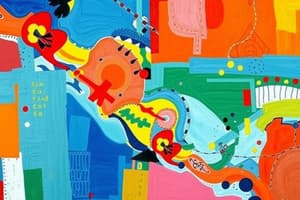Podcast
Questions and Answers
Which body of water borders Central America to the north?
Which body of water borders Central America to the north?
- Atlantic Ocean
- Caribbean Sea (correct)
- Gulf of Fonseca
- Pacific Ocean
What is the capital city of Central America?
What is the capital city of Central America?
- Managua
- San Pedro Sula
- La Ceiba
- Tegucigalpa (correct)
Which of the following is a major challenge faced by Central America?
Which of the following is a major challenge faced by Central America?
- Deforestation (correct)
- Strong economic stability
- High literacy rates
- Low tourism growth
Which traditional musical genre is NOT associated with Central American culture?
Which traditional musical genre is NOT associated with Central American culture?
What form of government does Central America operate under?
What form of government does Central America operate under?
Study Notes
Geography
- Located in Central America, bordered by Guatemala, El Salvador, and Nicaragua.
- Coastline along the Caribbean Sea to the north; the Pacific Ocean to the south (via the Gulf of Fonseca).
- Major geographical features include mountains, valleys, and coastal plains.
History
- Originally inhabited by indigenous peoples such as the Maya.
- Spanish colonization began in the 16th century; became part of the Captaincy General of Guatemala.
- Gained independence from Spain on September 15, 1821.
- Part of the Federal Republic of Central America until its dissolution in 1838.
Government
- Democratic republic with a presidential system.
- The President serves a four-year term and cannot serve consecutive terms.
- Legislative power is held by the National Congress.
Economy
- Primarily based on agriculture (coffee, bananas, palm oil).
- Manufacturing sector includes textiles and apparel.
- Tourism is growing, with attractions such as Mayan ruins and natural parks.
Population
- Approximately 10 million people.
- Major cities: Tegucigalpa (capital), San Pedro Sula, and La Ceiba.
- Diverse ethnic groups, including mestizo, indigenous, and Afro-Honduran communities.
Culture
- Rich cultural heritage influenced by indigenous, Spanish, and African traditions.
- Celebrations include Semana Santa (Holy Week), Garifuna Day, and Independence Day.
- Traditional music genres include Punta, Garifuna, and Marimba.
Language
- Spanish is the official language.
- Various indigenous languages are spoken, including Garífuna and Miskito.
Challenges
- Issues with poverty, corruption, and violence.
- High rates of crime, particularly related to gang violence.
- Environmental concerns, including deforestation and vulnerability to natural disasters like hurricanes.
Geography
- Central American nation bordered by Guatemala, El Salvador, and Nicaragua.
- Coastline along the Caribbean Sea in the north and the Pacific Ocean in the south, accessed via the Gulf of Fonseca.
- Features include mountains, valleys, and coastal plains, contributing to diverse landscapes.
History
- Originally home to indigenous groups, particularly the Maya civilization.
- Spanish colonization commenced in the 16th century; territory became part of Captaincy General of Guatemala.
- Achieved independence from Spain on September 15, 1821.
- Became part of the Federal Republic of Central America, which dissolved in 1838, leading to full sovereignty.
Government
- Functions as a democratic republic with a presidential system of governance.
- The President has a term of four years without the possibility of consecutive re-election.
- Legislative authority is vested in the National Congress, responsible for making laws.
Economy
- Economy heavily reliant on agriculture, notably the production of coffee, bananas, and palm oil.
- Manufacturing includes textiles and apparel, contributing to exports and job creation.
- Growing tourism industry capitalizes on attractions such as Mayan ruins and natural parks.
Population
- Population is approximately 10 million people, reflecting a diverse society.
- Major urban centers include Tegucigalpa (the capital), San Pedro Sula, and La Ceiba.
- Ethnic diversity includes mestizo (mixed), various indigenous groups, and Afro-Honduran communities.
Culture
- Cultural heritage is a blend of indigenous, Spanish, and African influences, creating a vibrant community.
- Major celebrations include Semana Santa (Holy Week), Garifuna Day, and Independence Day, reflecting cultural diversity.
- Traditional music genres such as Punta, Garifuna, and Marimba are important aspects of national identity.
Language
- Spanish serves as the official language, facilitating communication among the population.
- Indigenous languages like Garífuna and Miskito are also spoken, preserving cultural heritage.
Challenges
- Faces significant issues related to poverty and corruption, affecting governance and social stability.
- High crime rates, particularly related to gang violence, pose serious challenges to public safety.
- Environmental issues, including deforestation and vulnerability to natural disasters like hurricanes, threaten sustainable development.
Studying That Suits You
Use AI to generate personalized quizzes and flashcards to suit your learning preferences.
Description
This quiz explores the geography, history, and government of Central America, focusing on key features such as indigenous populations and economic sectors. Test your knowledge on major historical events and geographical landmarks within the region.




